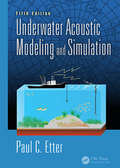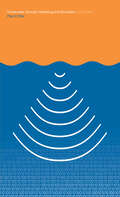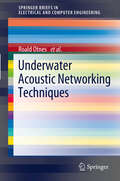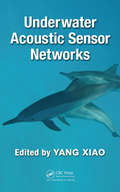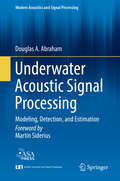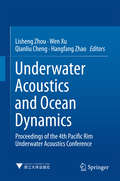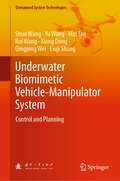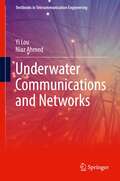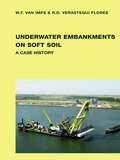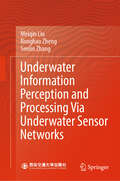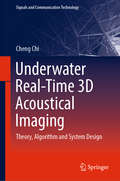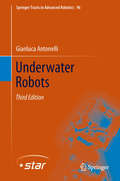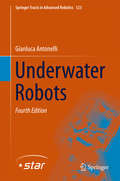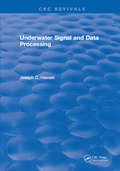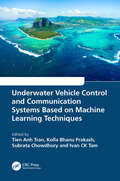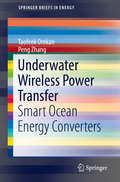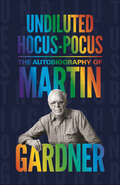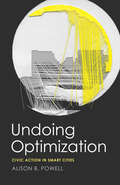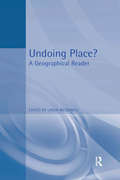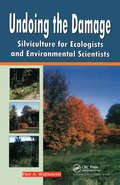- Table View
- List View
Underwater Acoustic Modeling and Simulation
by Bernt S. AadnoyThis newest edition adds new material to all chapters, especially in mathematical propagation models and special applications and inverse techniques. It has updated environmental-acoustic data in companion tables and core summary tables with the latest underwater acoustic propagation, noise, reverberation, and sonar performance models. Additionally
Underwater Acoustic Modelling and Simulation
by P.C. EtterUnderwater Acoustic Modeling and Simulation examines the translation of our physical understanding of sound in the sea into mathematical models that can simulate acoustic propagation, noise and reverberation in the ocean. These models are used in a variety of research and operational applications to predict and diagnose the performance of complex s
Underwater Acoustic Networking Techniques
by Michele Zorzi Michael Goetz Paul Van Walree Roald Otnes Ivor Nissen Knut Rimstad Thor Husøy Alfred Asterjadhi Paolo CasariThis literature study presents an overview of underwater acoustic networking. It provides a background and describes the state of the art of all networking facets that are relevant for underwater applications. This report serves both as an introduction to the subject and as a summary of existing protocols, providing support and inspiration for the development of network architectures.
Underwater Acoustic Sensor Networks
by Yang XiaoA detailed review of underwater channel characteristics, Underwater Acoustic Sensor Networks investigates the fundamental aspects of underwater communication. Prominent researchers from around the world consider contemporary challenges in the development of underwater acoustic sensor networks (UW-ASNs) and introduce a cross-layer approach for effec
Underwater Acoustic Signal Processing: Modeling, Detection, And Estimation (Modern Acoustics and Signal Processing)
by Douglas A. AbrahamThis book provides comprehensive coverage of the detection and processing of signals in underwater acoustics. Background material on active and passive sonar systems, underwater acoustics, and statistical signal processing makes the book a self-contained and valuable resource for graduate students, researchers, and active practitioners alike. <P><P>Signal detection topics span a range of common signal types including signals of known form such as active sonar or communications signals; signals of unknown form, including passive sonar and narrowband signals; and transient signals such as marine mammal vocalizations. This text, along with its companion volume on beamforming, provides a thorough treatment of underwater acoustic signal processing that speaks to its author’s broad experience in the field.
Underwater Acoustics and Ocean Dynamics
by Wen Xu Lisheng Zhou Qianliu Cheng Hangfang ZhaoThese proceedings are a collection of 16 selected scientific papers and reviews by distinguished international experts that were presented at the 4th Pacific Rim Underwater Acoustics Conference (PRUAC), held in Hangzhou, China in October 2013. The topics discussed at the conference include internal wave observation and prediction; environmental uncertainty and coupling to sound propagation; environmental noise and ocean dynamics; dynamic modeling in acoustic fields; acoustic tomography and ocean parameter estimation; time reversal and matched field processing; underwater acoustic localization and communication as well as measurement instrumentations and platforms. These proceedings provide insights into the latest developments in underwater acoustics, promoting the exchange of ideas for the benefit of future research.
Underwater Archaeology: The NAS Guide to Principles and Practice
by Nautical Archaeology Society (NAS)Underwater Archaeology: The NAS Guide to Principles and Practice provides a comprehensive summary of the archaeological process as applied in an underwater context. Long awaited second edition of what is popularly referred to as the NAS Handbook Provides a practical guide to underwater archaeology: how to get involved, basic principles, essential techniques, project planning and execution, publishing and presenting Fully illustrated with over 100 drawings and new colour graphics New chapters on geophysics, historical research, photography and video, monitoring and maintenance and conservation
Underwater Biomimetic Vehicle-Manipulator System: Control and Planning (Unmanned System Technologies)
by Rui Wang Yu Wang Shuo Wang Min Tan Xiang Dong Qingping Wei Liuji ShangThis book is about the design and control of biomimetic underwater robots. It explains the six aspects of the underwater biomimetic vehicle- manipulator system in detail and provides practical examples. This book is the authors’ long-term exploration of the theoretical and technical issues in the development of the underwater biomimetic vehicle-manipulator system and is written based on more than 15 years of scientific research and practical experience. This book is a helpful reference for the researchers, engineers, master and Ph.D. students in the field of biomimetic underwater robots.
Underwater Communications and Networks (Textbooks in Telecommunication Engineering)
by Yi Lou Niaz AhmedThis textbook covers all related communication technologies of underwater wireless communication, such as acoustic communication, optical communication, and magneto-inductive communication. After describing each technology, the authors relay their pros and cons, as it is essential to learn the underlying mechanism, advancements, and limitations of these techniques. Therefore, this book provides basics fundamentals of the three technologies, their advantages and disadvantages, and their applications. The authors also introduce research trends, pointing readers in the direction of research in the field of underwater wireless communication. The book is an essential textbook for undergraduate and graduate students in the field of underwater communications. The book is also useful as a reference to undergraduate engineering students, science students, and practicing engineers. The book includes end-of-chapter questions and numerical problems.
Underwater Embankments on Soft Soil: A Case History
by William F. Impe R. Daniel Verastegui FloresGround improvement is an established technique in foundation engineering. In recent decades, modern methods of ground improvement have utilised explosives, impact energy, thermal treatment of the soil, vacuum consolidation, vibratory compaction technologies, stabilization and solidification of soft soils, as well as combined systems of ingenious gr
Underwater Information Perception and Processing Via Underwater Sensor Networks
by Meiqin Liu Ronghao Zheng Senlin ZhangThis book highlights the latest advances and trends in information perception and processing of underwater sensor networks (USNs). Underwater sensor networks are networks of autonomous sensor nodes distributed over a given region of water to collaboratively perform a given task. Nearly 70% of the Earth's surface is covered by water, mainly oceans, and more than 80% of the ocean remains unexplored. The emergence of USNs is a new direction in ocean exploration and data collection. USNs offer many applications in both civilian and non-civilian fields. However, due to the characteristics of underwater environments, USNs face challenges such as limited bandwidth, high propagation delay, media access control, routing, resource utilization, power limitation, etc. Researchers have studied and provided many techniques over the past decades to address these issues. This book systematically summarizes the development and covers a wide range of applications of USNs, including mobile node localization, target detection, target recognition, target tracking, sensor scheduling, and environmental monitoring. It also focuses on the introduction of new technologies, including deep reinforcement learning, into underwater information perception and processing. This book is suitable for university lecturers, graduate students, and industry professionals working in the field of USNs.
Underwater Inspection and Repair for Offshore Structures
by Gerhard Ersdal John V. SharpBenefit from a much-needed, up-to-date handbook on underwater inspection and repair processes and technologies Underwater Inspection and Repair for Offshore Structures fills a gap in the literature to provide an overview of the inspection and repair processes for both steel and concrete offshore structures. Authors and noted experts on the topic John Sharp and Gerhard Esdal guide readers through the reasons why inspection and repair are performed and how both are linked to the management of structural integrity, statutory requirements and various types of damage. The book addresses critical topics, including the execution and planning of inspection and repair and the tools and methods used and their deployment underwater. The authors put particular focus on steel and concrete offshore oil and gas installations, but the content is also applicable to the substructures of offshore wind turbines. Underwater Inspection and Repair for Offshore Structures is complementary to the authors’ book Ageing and Life Extension of Offshore Structures, also from Wiley. This important book: Covers current inspection and monitoring techniques to evaluate existing structures Includes coverage of robotic (ROV) inspection and repair methods Provides an overview of repair and maintenance techniques applicable to the splash-zone and underwater operations Written for engineers, designers and safety auditors working with offshore structures. Underwater Inspection and Repair for Offshore Structures is a comprehensive resource for understanding how to effectively inspect and repair these vulnerable structures.
Underwater Real-Time 3D Acoustical Imaging: Theory, Algorithm and System Design (Signals and Communication Technology)
by Cheng ChiThis book presents the topic of underwater real-time 3-D acoustical imaging covering the theory, algorithms and system design. It summarizes recent advances in wideband and ultra-wideband underwater real-time 3-D acoustical imaging, which will be very useful for developing next-generation systems. Through simulation techniques, readers are able to quickly learn and develop practical underwater real-time 3-D acoustical imaging systems of their own.
Underwater Robots
by Gianluca AntonelliThis book, now at the third edition, addresses the main control aspects in underwater manipulation tasks. The mathematical model with significant impact on the control strategy is discussed. The problem of controlling a 6-degrees-of-freedoms autonomous underwater vehicle is deeply investigated and a survey of fault detection/tolerant strategies for unmanned underwater vehicles is provided. Inverse kinematics, dynamic and interaction control for underwater vehicle-manipulator systems are then discussed. The code used to generate most of the numerical simulations is made available and briefly discussed.
Underwater Robots: Motion And Force Control Of Vehicle-manipulator Systems (Springer Tracts In Advanced Robotics #96)
by Gianluca AntonelliA classic in underwater robotics. One of the first volumes in the “Springer Tracts in Advanced Robotics” series, it has been a bestseller through the previous three editions. Fifteen years after the publication of the first edition, the fourth edition comes to print. The book addresses the main control aspects in underwater manipulation tasks. With respect to the third edition, it has been revised, extended and some concepts better clustered. The mathematical model with significant impact on the control strategy is discussed. The problem of controlling a 6-degrees-of-freedoms autonomous underwater vehicle is investigated and a survey of fault detection/tolerant strategies for unmanned underwater vehicles is provided. Inverse kinematics, dynamic and interaction control for underwater vehicle-manipulator systems are then discussed. The code used to generate most of the numerical simulations is made available and briefly discussed.
Underwater Signal and Data Processing
by Joseph C. HassabA systematic and integrated account of signal and data processing with emphasis on the distinctive marks of the ocean environment is provided in this informative text. Underwater problems such as space-time processing relations vs. disjointed ones, processing of passive observations vs. active ones, time delay estimation vs. frequency estimation, channel effects vs. transparent ones, integrated study of signal, data, and channel processing vs. separate ones, are highlighted. The book provides the beginner with a concise presentation of the essential concepts, defines the basic computational steps, and gives the mature reader an advanced view of underwater systems and the relationships among their building blocks. It presents the needed topics on applied estimation theory within the underwater systems context. Included are topics in linear and nonlinear filtering, spectral analysis, generalized correlation, cepstrum and complex demodulation, Cramer-Rao Bounds, maximum likelihood, weighted least-squares, Kalman filtering, expert systems, wave propagation and their use, as well as their performance in applications to canonical ocean problems. The applications center on the definition, analysis, and solution implementations to representative underwater signal analysis problems dealing with signals estimation, their location and motion. The potential limitations and pitfalls of the implementations are delineated in homogeneous, noisy, interfering, inhomogeneous, multipath, distortions, and/or dispersive channels.
Underwater Structures: The Strength of Submarines and Deep-Diving Submersibles.
by Piero CaridisUnderwater Structures provides the necessary background theory of shell structures for the geometries encountered in submarine pressure hulls and deep-diving submersibles. Both analysis and design issues are considered, using analytical as well as numerical approaches. Classical thin-walled structures theory is implemented, and both elastic stability and collapse are considered for all types of structural geometries presented. These include ring-stiffened cylindrical shells, spheres, hemispherical shells, truncated cones, and torispherical end closures. This book also discusses structural design issues, including the selection of materials and the use of design codes. This book is suitable for university students at both the undergraduate and postgraduate level, and it also serves as a reference text for academic teachers, engineering professionals, and researchers.Key Features: Covers various types of submarines, both naval and civilian, and deep-diving submersibles Presents the latest in submersible structural design and includes both classical structures theory and finite element procedures Includes coverage of corrosion and fatigue in submarine structures
Underwater Vehicle Control and Communication Systems Based on Machine Learning Techniques
by Kolla Bhanu Prakash Tien Anh Tran Subrata Chowdhury Ivan Ck TamThe development of intelligent transportation systems, especially autonomous underwater vehicles, has become significant in marine engineering, with an aim to enhance energy efficiency management and communication systems. This book covers different aspects of optimization of autonomous underwater vehicles and their propulsion systems via machine learning techniques. It further analyses hydrodynamic characteristics including the study of experimental investigation combined with hydrodynamic characteristics backed by MATLAB® codes and simulation study results. Features: Covers utilization of machine learning techniques with a focus on marine science and ocean engineering. Details effect of the intelligent transportation system (ITS) into the sustainable environment and ecology system. Evaluates performance of particle swarm intelligence-based optimization techniques. Reviews propulsion performance of the remote-controlled vehicles based on machine learning techniques. Includes MATLAB® examples and simulation study results. This book is aimed at graduate students and researchers in marine engineering and technology, computer science, and control system engineering.
Underwater Wireless Power Transfer: Smart Ocean Energy Converters (SpringerBriefs in Energy)
by Peng Zhang Taofeek OrekanThis book discusses, for the first time, wireless power transfer in the ocean environment. Topics covered include power electronic techniques, advanced control strategies, as well as classic and emerging applications such as smart ocean energy systems and wireless power transfer and charging of underwater autonomous vehicles. Emerging research topics are presented, along with methodologies, approaches, and industrial development of intelligent and energy-efficient techniques. Apart from the basic principles with an emphasis on inductive power transfer and mathematical analysis, the book discusses the emerging implementation for underwater wireless power transfer such as energy encryption, power and data transfer through common links, and secured data- and cyber-security. Specifically, the book comprehensively introduces significant discussions on UWPT coil theoretical and experimental analysis in seawater, optimal design, and intelligent controls. For example, since fast communication is not viable in an underwater environment, the proposed book discusses Maximum Power Efficiency Tracking (MPET) control, which achieves a maximum power efficiency (>85%) without communication or feedback from the transmitting side of the UWPT system. A k-nearest-neighbors-based machine learning approach is used to estimate the coupling coefficiency between the coils. This machine learning-based intelligent control method can offer important guidance for graduate students, academic researchers, and industrial engineers who want to understand the working principles and realize the developing trends in underwater wireless power transfer. Finally, the book includes details on the modeling and design of a smart ocean energy system--a new type of power harvesting system designed to convert ocean energy into electricity, which has the capability of making underwater wireless power connections with distributed marine devices.
Undiluted Hocus-Pocus: The Autobiography of Martin Gardner
by Martin GardnerThe autobiography of the beloved writer who inspired a generation to study math and scienceMartin Gardner wrote the Mathematical Games column for Scientific American for twenty-five years and published more than seventy books on topics as diverse as magic, religion, and Alice in Wonderland. Gardner's illuminating autobiography is a candid self-portrait by the man evolutionary theorist Stephen Jay Gould called our "single brightest beacon" for the defense of rationality and good science against mysticism and anti-intellectualism.Gardner takes readers from his childhood in Oklahoma to his varied and wide-ranging professional pursuits. He shares colorful anecdotes about the many fascinating people he met and mentored, and voices strong opinions on the subjects that matter to him most, from his love of mathematics to his uncompromising stance against pseudoscience. For Gardner, our mathematically structured universe is undiluted hocus-pocus—a marvelous enigma, in other words.Undiluted Hocus-Pocus offers a rare, intimate look at Gardner’s life and work, and the experiences that shaped both.
Undoing Ethics
by Natasha WhitemanOver the past decade, researchers from different academic disciplines have paid increasing attention to the productivity of online environments. The ethical underpinnings of research in such settings, however, remain contested and often controversial. As traditional debates have been reignited by the need to respond to the particular characteristics of technologically-mediated environments, researchers have entered anew key debates regarding the moral, legal and regulative aspects of research ethics. A growing trend in this work has been towards the promotion of localized and contextualized research ethics - the suggestion that the decisions we make should be informed by the nature of the environments we study and the habits/expectations of participants within them. Despite such moves, the relationship between the empirical, theoretical and methodological aspects of Internet research ethics remains underexplored. Drawing from ongoing sociological research into the practices of media cultures online, this book provides a timely and distinctive response to this need. This book explores the relationship between the production of ethical stances in two different contexts: the ethical manoeuvring of participants within online media-fan communities and the ethical decision-making of the author as Internet researcher, manoeuvring, as it were, in the academic community. In doing so, the book outlines a reflexive framework for exploring research ethics at different levels of analysis; the empirical settings of research; the theoretical perspectives which inform the researcher's objectification of the research settings; and the methodological issues and practical decisions that constitute the activity as research. The analysis of these different levels develops a way of thinking about ethical practice in terms of stabilizing and destabilizing moves within and between research and researched communities. The analysis emphasizes the continuities and discontinuities between both research practice and online media-fan activity, and social activity in on and offline environments.
Undoing Optimization: Civic Action in Smart Cities
by Alison B PowellA unique examination of the civic use, regulation, and politics of communication and data technologies City life has been reconfigured by our use—and our expectations—of communication, data, and sensing technologies. This book examines the civic use, regulation, and politics of these technologies, looking at how governments, planners, citizens, and activists expect them to enhance life in the city. Alison Powell argues that the de facto forms of citizenship that emerge in relation to these technologies represent sites of contention over how governance and civic power should operate. These become more significant in an increasingly urbanized and polarized world facing new struggles over local participation and engagement. The author moves past the usual discussion of top-down versus bottom-up civic action and instead explains how citizenship shifts in response to technological change and particularly in response to issues related to pervasive sensing, big data, and surveillance in &“smart cities.&”
Undoing Place?: A Geographical Reader (Arnold Readers In Geography Ser.)
by Linda McDowellDoes geography affect our sense of 'self'? How are social characteristics mapped out on the ground? And is there any 'authentic' sense of place now, or are we increasingly 'placeless'?Concentrating on the period between the end of the Second World War and the end of the century, this Reader argues that there is a reciprocal relationship between the constitution of places and people. What it means to be a man or a woman , to have a nationality and a sense of place, has been transformed and reinvented as our view of the world has changed. The present is perceived as a time of fear, a period in which all that is solid seems to melt into air, while the 1950s are a site of nostalgia, a period of clarity and certainty, a time when people know their place.Bringing together an interdisciplinary collection of articles for social and cultural geographers, this Reader critically examines the argument that the close associations of the 1950s between place (the home, the community and the nation state) and the social divisions (gender, class and nationality) are breaking down in the 1990s. Drawing out the oppositional movements in each decade, it seeks to show how the supposed stability of one and the mobility of the other are exaggerated.
Undoing the Damage: Silviculture for Ecologists and Environmental Scientists
by P A WojtkowskiAs a natural science, silviculture has a large say in how humans interact with the terrestrial world. Although the perspective taken here that the production of wood is narrow, the amount of land area consumed is extensive; the indirect consequences of wood production on natural processes are larger still. Through the amount of land engaged, the flora and fauna affected and the environmental consequences, good or bad; silviculture is a frequent constituent in applied ecology, environmental science, conservation ecology and other broad land-use disciplines. Silvicultural expertize is essential when trees and wood are an economic output; often best promoted when silviculture is allied with hydrology, ecology, soil science, wildlife management, etc. This book touches upon the following important areas of the subject in detail.
Undress for Success: The Naked Truth about Making Money At Home
by Kate Lister Tom HarnishThis book is for the bummed out, burned out, and stressed out professional, stay-at-home parent, or retiring boomer who dreams of a home-based job or business, but doesn't know how to make that dream a reality. Unlike the many "change-your-life" books that promise much and deliver little-Undress4Success provides expert, practical advice about: 1) what home-based jobs are available, what talents they require, what they pay, who's hiring, and how to land one; 2) how to use the Web to search for work-at-home jobs and business opportunities without being scammed; 3) how to turn professional talents into a freelance business; and 4) how to convince an employer to adopt a telecommuting program. Based on interviews with dozens of employers, home-based employees, successful freelancers, and leading telework researchers, this book shows readers the way home.
